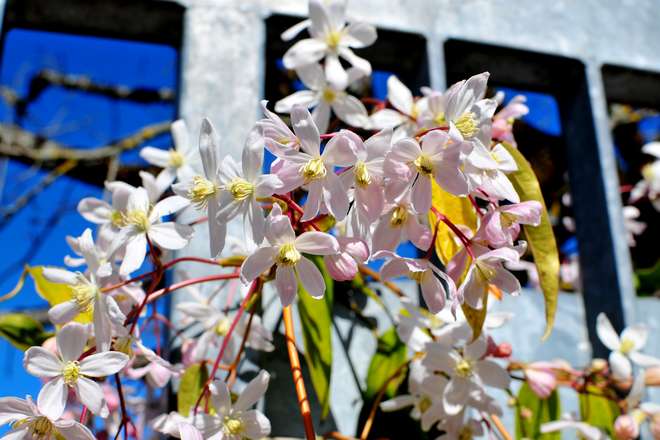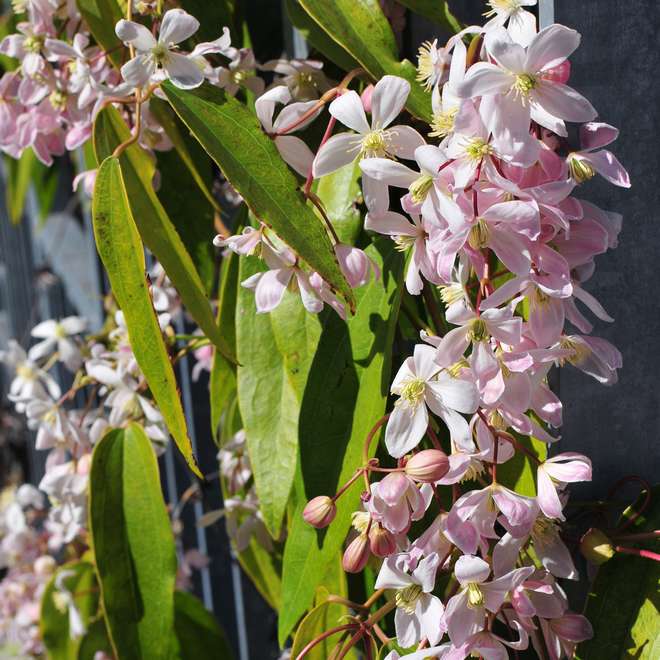
Not all clematis are deciduous in winter! Some are evergreen , such as Armand’s clematis, discovered by the French Lazarist missionary Jean-Pierre Armand David (1826-1900). A valuable climber during the off-season.
What there is to know :
Botanical name : Clematis armandii
Common name : Armand’s Clematis
Height : Can reach 4 to 6 m high
Foliage : Broad and leathery leaves, dark green and divided into three lobes. They wrap around the support by their petiole.
Flowers : Its flowers in pure white, fragrant stars, hatch in February-March at the end of the stems.
Exposure : bright and sunny, preferably South or South-West.
Soil : All land, except that which is waterlogged in winter.
Hardiness : Withstands cold down to -15°C
Cultivation of Armand’s clematis
Although relatively chilly in the first years, once established, Father Armand’s clematis is hardy down to -15°C. Install it nevertheless in the sun or in partial shade, in a warm situation, in a well-drained soil, to see it generously covered with flowers.
This climber particularly appreciates the mild and humid climate of the Atlantic coast and the hotter and drier one of the Mediterranean rim.
A vigorous climbing plant
Armand ‘s evergreen clematis is a vigorous vine that can reach nearly 5 to 10 meters in length. It clings to its trellis support thanks to its tendrils. It therefore needs the support of a wall, a trellis, a pylon, a fence or a planter fitted with a trellis.
Its long dark green leaves are compound, leathery and shiny. Its young shoots are tinged with light purple.
The starry white flowers, formed of four narrow petals, are numerous and appear early when the winter is not too harsh, from February in mild climates, in March elsewhere. They exhale a delicate fragrance combining orange blossom and vanilla.
More rarely, at the end of summer, it is possible to observe a second, lighter flowering.

Planting a clematis
Planting should be done in the spring, after the end of flowering. In mild regions, it is preferable in the fall, in September, October or November, in mild, even rainy weather.
Choose a bright location, sheltered from the wind.
- Dig a hole 40 cm wide and deep;
- Mix half of good horticultural soil with the original soil.
- Bathe the root ball in a bucket of water to moisten it;
- Depot, gently disentangle the roots by hand.
- Install the plant in the center of the hole, oriented slightly at an angle towards the trellising support, then remove the stake by sliding it. If your soil is heavy, lay a 3cm bed of gravel at the bottom to improve drainage.
- The first 15 centimeters of the stem must be buried to promote the birth of new shoots. Backfill to a height of 30 cm with the prepared soil mixture.
- Water generously: 10 liters of non-calcareous water.
- Mulch the remaining 10 to 15 cm with compost. Future shoots from the base or old wood will take root there more easily.
- Tie the branches to the trellis or fence. Later, this voluble climber will hang on by itself.
- Finish by pouring in an additional 1-2 liters of water to moisten the surface compost.
Be careful not to mulch the feet with stones, gravel, slate… You would then prevent the new shoots from emerging!
Pruning Armand’s clematis: when?
If you must contain it, know that this vigorous, persistent vine always prunes at the end of flowering .
To maintain it gently, do not hesitate to completely remove an old branch every year. Its large diameter and the dark green color of the leaves it bears makes it easy to identify.
It is also possible to rejuvenate an Armand’s clematis by folding it completely close to the ground. The plant tolerates it very well. This severe pruning is necessary, for example, to repaint the trellis support.
Remarkable varieties
All varieties of Armand’s clematis are evergreen. This is what distinguishes it from the clematis montana which nevertheless flowers at the same time.
Armand’s Clematis “Apple Blossom”
Its very elongated evergreen foliage perfectly highlights the bright pink buds opening onto astonishing white flowers tinged with soft pink. The flowers are all delicately scented.
Armand Avalanche Clematis
With a bushy habit, this variety well deserves its name as it is covered with a veritable avalanche of white flowers! Its very finely cut evergreen leaves resemble those of daisies, providing a superb setting for its beautiful flowering. In spring, the pure white flowers exhibit a tuft of yellow stamens.
How to use Armand’s clematis?
Try combining an evergreen clematis with a large-flowered deciduous variety to enjoy flowering almost all year round! The association with pink or white climbing roses is also very elegant.
